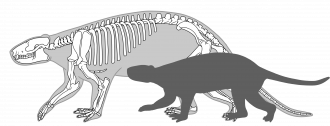Media release
From:
Palaeontology: Early mammals lived fast and died young *IMAGES*
The earliest large, post-dinosaur mammals grew up twice as fast as equivalent-sized modern-day mammals and had comparatively shorter lifespans, according to research in this week’s Nature. The study, which highlights the unique life history of these prehistoric animals, helps to explain how mammals rose to prominence after the demise of the dinosaurs.
Mammals responded to the extinction of the dinosaurs by diversifying and increasing in body size. Pantodonts were the earliest-known group of large herbivores to emerge during this time. They evolved into a broad range of forms but died out in the Eocene, and their relationship with later mammals is unclear. In this study, Gregory Funston, Steve Brusatte and colleagues use a variety of methods, including dental trace element mapping, to elucidate the life history of the 62 million-year-old pantodont Pantolambda bathmodon. Although the inferred gestation time of around seven months matches that of similarly sized living mammals, P. bathmodon is found to have lived and died more rapidly. The young were born in an advanced developmental state and were weaned within one or two months; they then died before they were ten years old.
This life history has no modern analogue. Although P. bathmodon reproduced like a placental mammal, it lived at an unusually fast pace for its large body size. The findings suggest that extended gestation periods were already in existence 62 million years ago, and that larger newborn sizes may have contributed to the rapid size increase observed in early placental mammals.
Multimedia






 International
International

